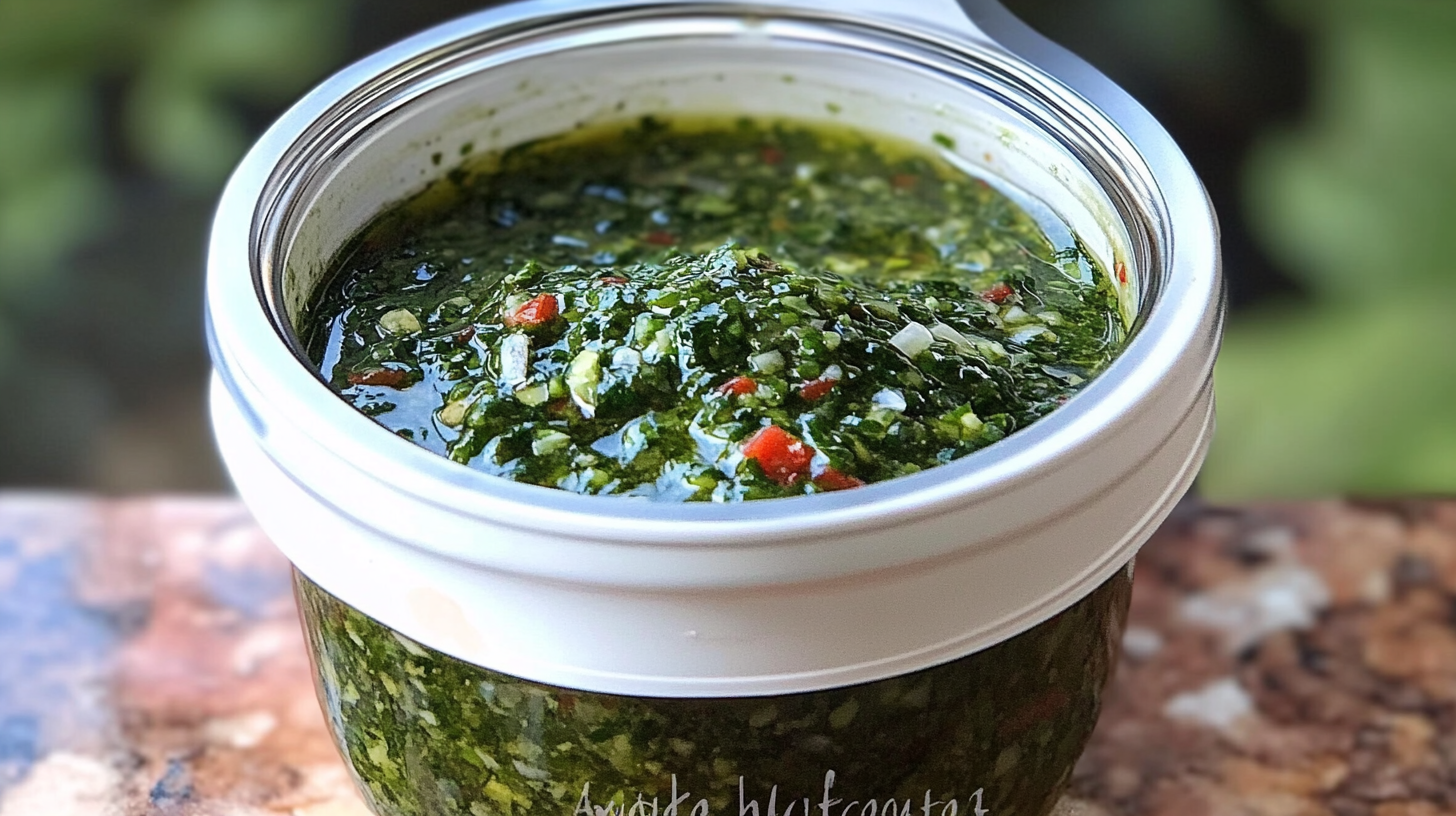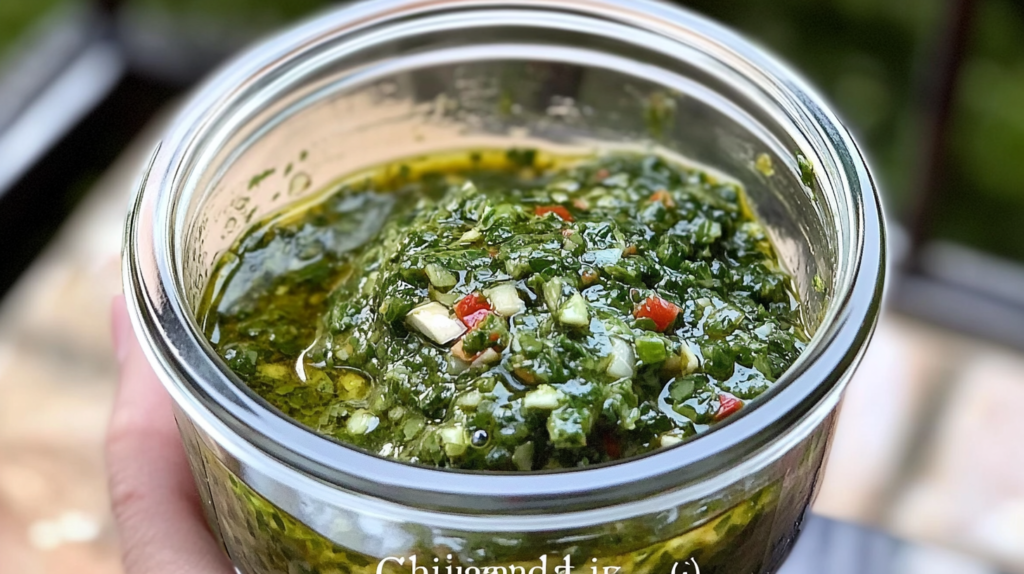Chimichurri is a vibrant, herb-filled sauce with roots in South American cuisine, especially Argentina and Uruguay. Known for its bold, garlicky flavor, chimichurri is often enjoyed as a condiment for grilled meats but has evolved to become a versatile addition to many dishes worldwide. This guide explores everything from the history and traditional ingredients of chimichurri to unique uses, storage tips, and delicious variations. Whether you’re a seasoned chef or a home cook, get ready to bring this flavorful condiment into your kitchen in creative ways.
What is Chimichurri?
Chimichurri is a traditional sauce known for its robust flavors, made with fresh herbs, garlic, oil, and vinegar. It’s typically prepared as a green or red sauce, depending on ingredients, and is beloved for enhancing grilled dishes, especially meat. The sauce is thought to have originated in Argentina, where it quickly became a staple at asados (barbecues) and has since become popular globally.
Origins and History of Chimichurri
The origin of chimichurri is closely tied to Argentinian culture, where it developed as a flavorful complement to the country’s rich tradition of grilling. Asado gatherings—where friends and family come together to grill meat—are an essential part of life in Argentina, and chimichurri adds a fresh contrast to the smokiness of the meat. The exact history is somewhat mysterious, but it’s believed that chimichurri may have been influenced by Spanish and Italian immigrants who brought culinary traditions that combined oil, vinegar, and fresh herbs.
Essential Ingredients for Chimichurri
To make a classic chimichurri sauce, you’ll need a few core ingredients that bring together fresh, earthy flavors and a bit of tang. The beauty of chimichurri lies in its simplicity and adaptability, with options for adding a personal touch.
Traditional Ingredients in Chimichurri
- Parsley: The star of most chimichurri recipes, parsley brings a fresh, slightly peppery note.
- Oregano: This herb adds a warm, aromatic layer to the sauce, complementing the parsley.
- Garlic: Essential to chimichurri, garlic provides a bold kick, enhancing the flavor profile.
- Vinegar: Typically white or red wine vinegar, this adds the tangy contrast that defines chimichurri.
- Olive Oil: Acting as the base, olive oil binds the ingredients and adds a smooth texture.
- Salt and Pepper: For seasoning, balancing the flavors in the sauce.
Optional Ingredients and Variations
While traditional chimichurri uses parsley and oregano, there are plenty of ways to customize it:
- Cilantro: Adds a unique, slightly citrusy note, often used in chimichurri variations.
- Red Pepper Flakes: For a hint of spice, many choose to add a sprinkle of red pepper flakes.
- Shallots or Red Onion: Finely chopped, these add a slight sweetness and additional texture.
How to Make Chimichurri
Making chimichurri is incredibly straightforward, and with a few easy steps, you can prepare this sauce in under 10 minutes. It’s often made in one bowl, saving time and reducing cleanup.
Step-by-Step Recipe for Classic Chimichurri
- Prepare the Ingredients: Finely chop parsley, oregano, and garlic.
- Mix the Ingredients: In a medium bowl, combine the chopped herbs with vinegar, olive oil, salt, and pepper.
- Adjust Seasoning: Taste and adjust seasoning to your preference, adding more salt, vinegar, or olive oil if desired.
- Let the Flavors Marry: Allow the chimichurri to sit for about 10 minutes before serving to let the flavors blend.
Video Guide
For visual learners, watching a quick chimichurri preparation video can help refine your technique. Many chefs suggest using a mortar and pestle for an extra smooth texture, while others prefer a more rustic chop for added texture.
Chimichurri Variations
Experimenting with different herbs and spices can help you make chimichurri that suits your taste or complements specific dishes. Here are some regional and creative variations you might enjoy.
Regional Chimichurri Variations
- Argentinian Chimichurri: Stays close to the traditional recipe with parsley, oregano, and garlic.
- Uruguayan Chimichurri: Often a bit thinner in consistency and may include ingredients like bay leaf and shallots.
- Red Chimichurri: Uses paprika or red peppers, adding a different hue and a smokier flavor.
How to Customize Chimichurri to Your Taste
Want to make chimichurri spicier, tangier, or even a bit sweeter? You can:
- Add Spice: Mix in fresh or dried chilis for a kick.
- Experiment with Herbs: Try basil, thyme, or rosemary for an herbaceous twist.
- Sweeten the Sauce: Add a small amount of honey or agave to balance any bitterness.
Serving Suggestions for Chimichurri
Chimichurri is highly versatile and works well as a sauce, marinade, or topping, adding a burst of fresh flavor to many dishes.
Using Chimichurri as a Sauce
Grilled Meats: The most traditional use, chimichurri is served alongside grilled steak, chicken, or pork, enhancing the rich flavors with its herbal freshness.
Vegetables: Drizzle chimichurri over roasted or grilled vegetables like bell peppers, zucchini, and mushrooms for an extra layer of flavor.
Seafood: Pair it with grilled shrimp, salmon, or white fish for a tangy complement that brightens the dish.
Chimichurri as a Marinade
Marinating meat in chimichurri infuses flavors deeply, creating a delicious base for grilling or roasting. The acid in the vinegar tenderizes the meat while the garlic and herbs build a bold profile.
- Chicken: Marinate for at least 30 minutes, or up to a few hours.
- Beef : Marinate for 2–6 hours to allow the flavors to soak in.
- Seafood: A quick 15–30 minutes is ideal for delicate proteins like fish.
Storage and Shelf Life of Chimichurri
To keep your chimichurri fresh and flavorful, proper storage is key. Thankfully, it’s a sauce that stores well and can be enjoyed over several days.
How to Store Chimichurri
- In the Refrigerator: Store chimichurri in an airtight container for up to 5–7 days. It may separate over time; simply stir to recombine before use.
- Freezing Chimichurri: For longer storage, freeze chimichurri in an ice cube tray. Once frozen, transfer the cubes to a freezer bag, allowing you to thaw small portions as needed.
Tips for Maintaining Freshness
Adding a thin layer of olive oil on top of the chimichurri before sealing it helps preserve its bright green color and prevents oxidation. Also, if you make a large batch, freezing part of it right away ensures it stays fresh for later use.
Health Benefits of Chimichurri
Not only is chimichurri delicious, but it also provides a range of health benefits thanks to its nutrient-rich ingredients.
Nutritional Profile of Chimichurri
- Parsley: High in vitamins A, C, and K, parsley has antioxidant properties that support immune health.
- Garlic: Known for its anti-inflammatory and immune-boosting effects, garlic is also thought to support heart health.
- Olive Oil: A heart-healthy fat, olive oil provides essential monounsaturated fats and antioxidants.
How Chimichurri Supports a Balanced Diet
As a low-calorie, flavor-packed condiment, chimichurri adds zest to meals without extra sugar, processed fats, or artificial additives. Its fresh ingredients make it a great choice for anyone seeking a nutritious and natural way to enhance food.
Creative Chimichurri Variations
While the classic chimichurri recipe is loved for its bright, fresh flavor, there are several ways to adapt it for different tastes or cuisines. Here are a few unique variations to try:
Cilantro Chimichurri
Swap half or all of the parsley for fresh cilantro. This variation offers a more tropical flavor that pairs wonderfully with Mexican dishes, grilled shrimp, or fish tacos.
Spicy Chimichurri
Add red pepper flakes, fresh chopped jalapeño, or a pinch of cayenne for a kick of heat. This version works especially well with grilled chicken or beef.
Lemon Basil Chimichurri
Replace vinegar with fresh lemon juice and add a handful of basil leaves for a milder, citrusy profile. This twist is perfect with lighter proteins like fish or as a salad dressing.
Smoky Red Chimichurri
Include smoked paprika and red chili flakes to give your chimichurri a smoky depth. This version pairs beautifully with grilled vegetables, roasted potatoes, or barbecued meats.
Mint and Dill Chimichurri
Adding fresh mint and dill can create a Greek-inspired chimichurri, ideal for lamb dishes or as a topping for Mediterranean-style salads and roasted veggies.
This part would allow readers to explore different ways to adapt chimichurri to their preferences, making the article more comprehensive and appealing to a wider audience. Let me know if this addition fits!
Frequently Asked Questions (FAQs) about Chimichurri
What’s the difference between green and red chimichurri?
Green chimichurri uses fresh parsley and oregano, while red chimichurri often includes paprika or red chili peppers, giving it a distinct color and slightly different flavor.
Can chimichurri be used as a pasta sauce?
Yes! Chimichurri can be tossed with pasta for a fresh, herbaceous twist on a classic dish. Consider adding a little extra olive oil for a smoother consistency.
Is chimichurri spicy?
Traditional chimichurri is not particularly spicy, but you can add fresh or dried chilies to adjust the heat level to your liking.
What’s the best way to use leftover chimichurri?
Besides using it as a sauce, mix leftover chimichurri into rice, use it as a sandwich spread, or add a spoonful to scrambled eggs for extra flavor.
This comprehensive guide covers the many facets of chimichurri, from its origin and ingredients to creative uses and health benefits. Let me know if you’d like additional insights or details on any part!

